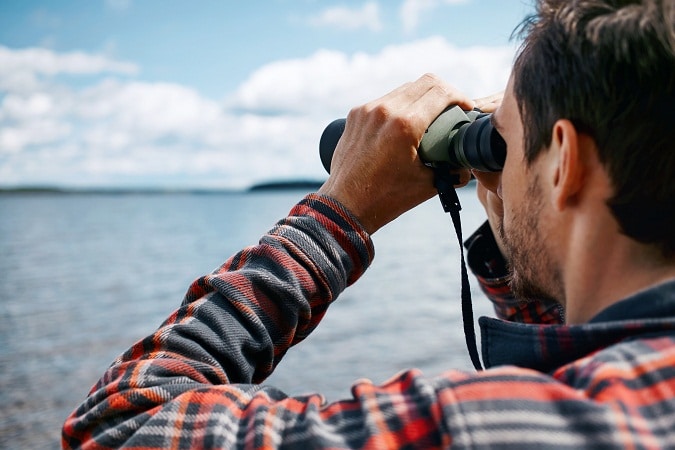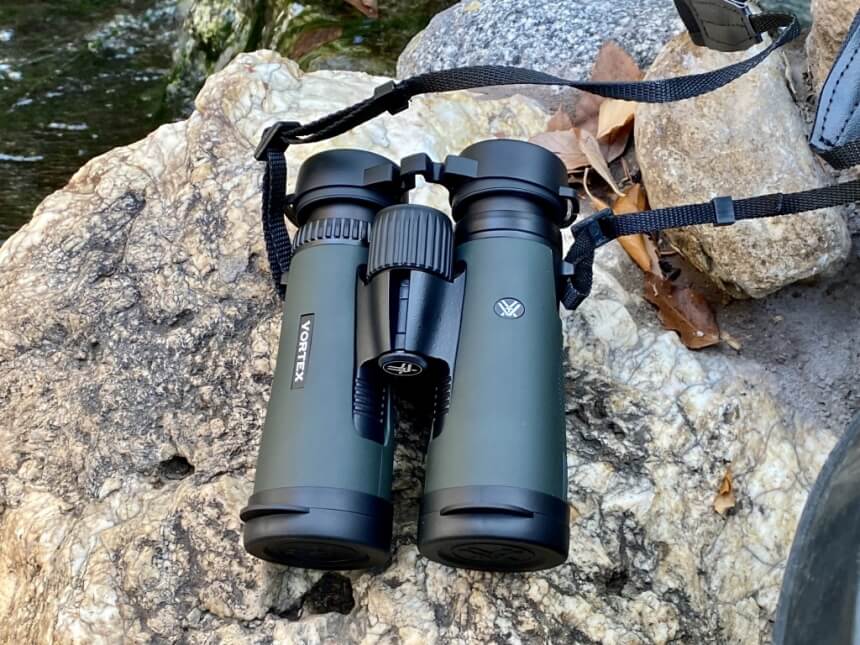

Is it your first time heading to a safari, and you want to get a fantastic experience? Or you enjoy watching wildlife and wish to find the top-quality equipment for your hobby? If the answer to any of these questions is yes, the best binoculars for safari can deliver to you everything you might imagine!
We searched the market up and down and came across 47 different pairs of binoculars. For this review, we’ve singled out the Nikon 7576 MONARCH 5 Binoculars as our favorite. That is because its features fit the requirements of an experienced user, but they are also easy to use even for beginners. Impressive image quality and sharpness come as a given, and we were thrilled with excellent light transmission. The product is made of high-quality components and very durable. Apart from that pair, we also gathered nine other binoculars to make the selection process easier.
While reviewing the products, we focused on the crucial features of these units. Our article explores more about the magnification and objective diameter as basic parameters for adjusting the product. We also focused on the field of view so that you don’t miss a single detail, as well as physical characteristics like weight and dimensions. These can be important for carrying the product around and using it for hours. Our team spent more than 65 hours searching for safari binoculars. We used official websites, industry magazines, user opinions, and other relevant sources. Our authors gathered all relevant facts and pointed them out in the detailed reviews. Before you read them, our comparison table shows a quick overview of the selected binoculars. And don’t forget to check our buying guide to learn more about them. Once you have all the information, it will be easy to pick a suitable model for your needs!
More features: waterproof, fog proof, rubberized armor, high light transmittance, turn-and-slide rubber eyecups, nitrogen-filled and O-ring sealed
The Nikon 7576 Monarch 5 is the fifth edition of binoculars in this series. Over time, the manufacturer improved this product and turned them into one of the best lightweight binoculars for safari out there. Apart from the 8x magnification model, it is also possible to go with a 10×42 pair.
The product is built for extreme use by professionals. Since it is easy to use, beginners like it, too. The image quality is excellent due to coated eco lenses with extra-low dispersion glass. The binoculars have excellent light transmission. And although the close focus could be better, overall image clarity is excellent and easy to adjust.
Apart from the durable lens housing, the binoculars have a rubber armor. That absorbs shock to promote the product’s durability. However, the lens caps do not provide adequate protection. You should consider replacing them after a while, especially if you plan to head into extreme conditions.
More features: O-ring sealed and nitrogen purged, BAK-4 prisms and multi-coated optics, 17mm eye relief
You can choose the standard 10x model of the Bushnell H20, or go with the 8x magnification model. Either way, you get a 42mm objective diameter and a fairly big field of view.
Although the price is affordable, the manufacturer used durable components. An excellent waterproof rating comes from O-ring seals and nitrogen-purging. However, fog resistance could be better, especially since it is one of the selling points of the product. The binoculars have a generous eye relief, as well as a close focus distance set at 12 feet.
The product features HD image quality, but there is a noticeable chromatic aberration in some cases. The non-slippery rubber armor protects the product from shock and also ensures convenient use. Other nice additions include twist-up eyecups and a large focus knob.
More features: BAK-4 roof prisms, multi-coated dielectric optics, extra-low dispersion glass, IPX7 waterproof rating, nitrogen-filled and O-ring sealed
Hawke designed these premium binoculars for a safari with carefully chosen components. They used nitrogen fillings and O-ring sealing for the optical tubes, which gained them a high IPX7 waterproof rating. The product is a bit heavy, and that makes it tricky to carry around for hours on your neck. However, it features an attractive design and premium-quality components.
The product offers excellent clarity and sharp image because of the multi-coated optics, including phase-coated BAK-4 prisms. The binoculars also come with low-dispersion glass and impressive light reflectivity. The objective diameter is quite standard, but it will do the trick. The binoculars are also great for a close focus of up to 6.6 feet. Adjusting the focus is easy, which makes the unit suitable for beginners.
More features: waterproof, 16mm eye relief, comes with carrying case, lens caps, eyepiece rainguard, neck strap, lens cloth, and instruction manual
It is easy to pick the best binoculars for African safari when you have a wide range of sizes available. The Celestron 71336 is available in 8×32, 8×42, 10×32, 10×42, and 10×56 models. However, we particularly liked the 12×56 since it features perfect magnification and wide objective diameter.
Phase-coated BAK-4 prisms and multi-coated lenses secure excellent brightness, contrast, and clarity of the images. It doesn’t matter if you wear glasses because twist-up eyecups ensure the product is versatile and suitable for everyone.
Although the binoculars fit well in your hands, this is not the lightest unit out there. The product is long-lasting and features polycarbonate housing and rubber armor.
The manufacturer included a neck strap, detailed instructions, and a cloth for cleaning the lenses. The eye focus ring is a bit tricky to turn, but you should get used to that after a while.
More features: BAK-4 prisms, multi-coated lens, waterproof, fog-proof, and shockproof, twist-up eyecups
The Leupold BX-1 McKenzie Binoculars are very durable and resistant to hits and shocks. The product is also waterproof, and its fog-resistance ensures there is no condensation on your lenses. The multi-coated lenses guarantee optimal image quality. However, the lens caps fall out easily, which might lead to unwanted damages to your lenses if you don’t store the product properly.
These binoculars for safari feature excellent clarity because they come with BAK4 prisms. Although the focus is sensitive, you should get used to it over time. The roof prism design makes them ergonomic, which prevents hand fatigue when using the product.
The binoculars come with 12x magnification and impressive eye relief to enable extended viewing. You will get additional time to use them during the twilight thanks to the light management system included.
More features: 1-year money-back guarantee, IPx3 waterproof rating, package includes attachable lens caps, smartphone adapter, tripod & bracket mount, neck strap, carrying case, cleaning cloth, & user manual
The Noptix Safari Binoculars offer an all-in-one package for a person who wants to observe wildlife and take great photos. The box contains everything you might need, including a tripod, phone adapter, neck strap, and a carrying case. The price is a bargain deal for the entire package. However, that also means the overall durability could be better, although you get a lot for the cost.
The accessories are easy to use. As long as you follow the instructions, even beginners will find their way around easily. The binoculars are equipped with anti-reflective multi-coated lenses for optimal image sharpness and clarity. The product comes with a decent IPX3 waterproof rating and generous eye relief. Unfortunately, not everyone liked using them with glasses. The magnification is up to 10x, and the lens caps are attached so that you don’t lose them.
More features: multi-coated optics. BAK-4 prisms, rubberized armor, fully water and fog proof, extra-low dispersion
Snypex designed a high-quality product, and these might be the best compact binoculars for safari. Since the price tag is a bit high, you expect a long-lasting and durable unit, and the manufacturer delivers that.
The polycarbonate housing is reinforced with fiberglass, and rubber armor does a great job at shock absorption. The binoculars are fog proof and resistant to condensation. Moreover, they are submersible up to 3.3 feet, and they can hold for up to 15 minutes in water. The unit weighs only 13 ounces, and it is light to carry around for hours.
As for the performance, the binoculars feature excellent image quality and impressive light control. Many users love the clarity it gives, although the objective diameter isn’t as wide as in similar units.
More features: tripod adapter socket, twist-type retractable eyecups, multi-coated BAK-4 optics, rubber armor
For those who are looking for the best travel binoculars for safari, Opticron Traveller BGA ED might be a smart choice. The product is incredibly durable and resistant to shocks. The lens covers, as well as rubber armor, and all other components will stand the test of time easily. That makes them suitable for traveling and using in extreme conditions.
The retractable eyecups can be adjusted to four different settings. Whether you wear glasses or not, it will be easy to use these binoculars. Although the objective diameter could be bigger, the impressive field of view compensates for that. The image quality is unmatchable, and the product features multi-coated BAK-4 prisms with Oasis coating. Apart from high product quality, you can also expect excellent image sharpness, which justifies the price tag.
More features: lifetime limited warranty, gas purged and sealed O-ring sealed, comes with neck strap, cleaning cloth, rainguard, hard case
With this wonderful product, we will be focusing on the 10×50 model, but the Xgazer Optics is also available in 8×32, 8×42, 10×42, and 12×50 variations. It doesn’t matter which specifications you choose because you will get high-quality binoculars for safari either way.
The product is versatile and suitable for outdoor use. Nitrogen-purging and O-ring seals ensure that the moisture and condensation don’t affect the lenses. The lens covers ensure to protect them on both sides. The rubber armor is shockproof, and the product comes with the hard case to make it last longer.
As for the other accessories, the package includes a neck strap, cleaning cloth, rain-guard, and user instructions. Unfortunately, the weight might make it hard to wear the binoculars the entire day.
More features: comes with protective pouch, neck strap, lens covers, and lens cloth, 21mm eye relief, tripod mountable
Apart from the standard 8×42 model, you can also choose other Carson JR Series Binoculars variations. The standard green color is available with both sizes, but you can also pick a camo design with a larger size. The mossy oak camouflage is great for outdoor use, and it ensures additional protection against the animals noticing you. The only downside is that there are no larger or smaller objective diameters offered.
The binoculars offer everything you need for safari, including a wide field of view, impressive eye relief, and a close focus distance of 20 feet. The product weighs only above a pound, which makes it suitable to use for hours. However, it might be tricky to use it while wearing eyeglasses. The durability is optimal, and the binoculars provide great water and fog resistance.
Are you wondering how to choose binoculars for safari? That will depend on a lot of factors, including your preferences, but also the products’ characteristics. You should consider both performance and durability, as well as the design of the binoculars. We singled out the most important factors to consider during the buying process. Our authors also answered the most common questions about safari binoculars. Take a look at our shopping guide and learn everything you need to know how to pick suitable equipment for your next adventure!
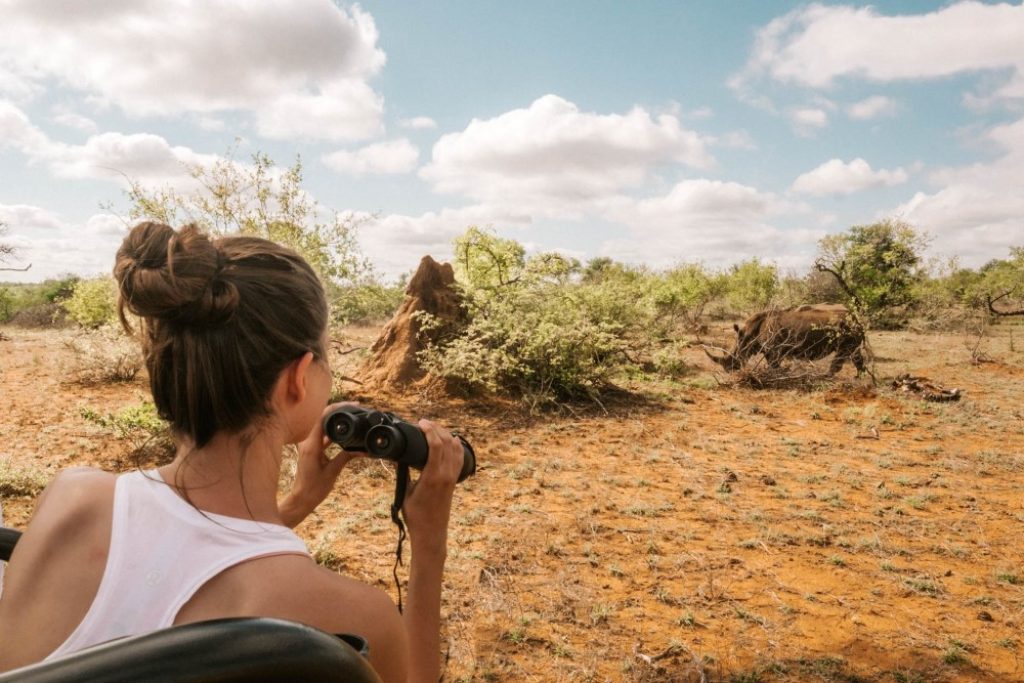
If you read our binoculars for safari reviews, you probably understand which features are crucial for these products. In this section, we will focus on explaining crucial factors to consider during the purchasing process. We will analyze the construction of binoculars, how each component affects their performance, as well as what affects durability. Here is what you need to know to maximize your upcoming safari experience. Read carefully, and don’t forget it is all about finding a product that meets your expectations!
When choosing safari binoculars, you can pick between two different types of prisms – Porro and roof. The task of the prism is to secure a light path from the lens to the eyepiece. The light path affects magnification without adjusting the tube length.
Porro prisms were designed first, and they got the name by their author Ignazio Porro. The Italian scientist implemented two prisms facing each other at right angles. The Bushnell H20 Binoculars are an example of these binoculars. Since the eyepiece and lens are not in the line, the light gets jagged sideways during its journey.
Roof prisms feature different styles. Although they appear like the lens and the eyepiece are in line, the light has a complicated path inside the product. Despite that complexity, technology does the job above all expectations. The idea was to improve image quality and maximize clarity as much as possible, and it turned out to be a success. Today, roof prisms are almost a standard in all advanced binoculars.
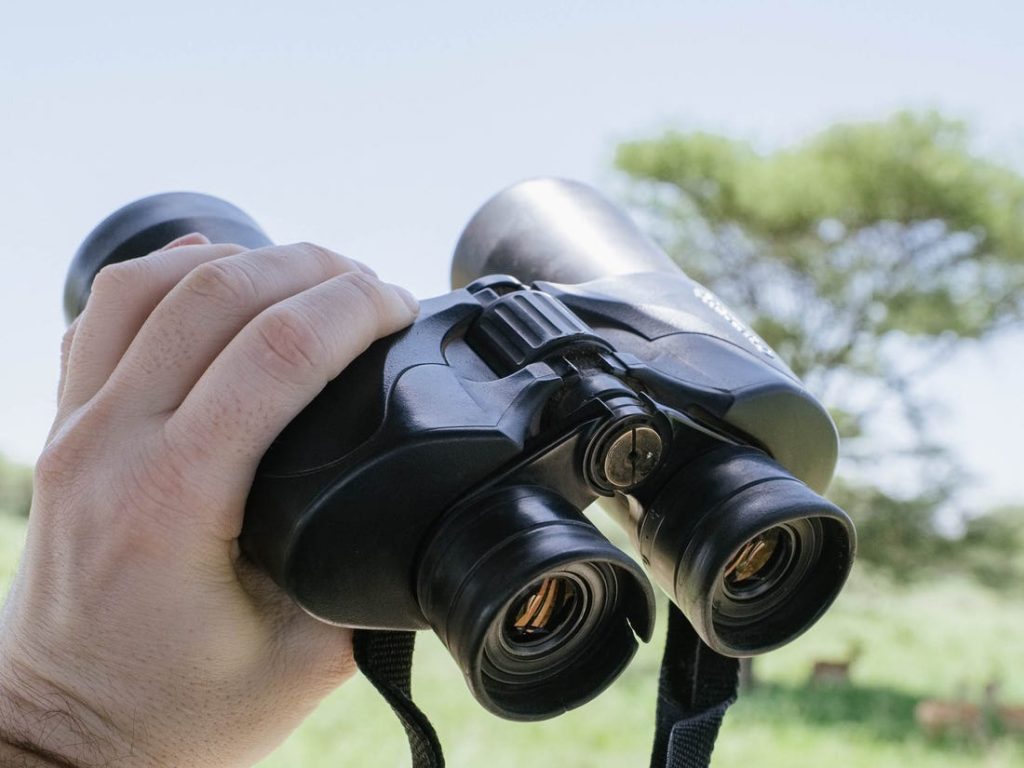
Since the diameter affects the size of the product, it is also important if you are looking for the best compact binoculars for the safari.
The reason why you should stick to binoculars over 32mm is that they transmit more light and control it in a way that delivers excellent image clarity and quality.
Additionally, a large diameter is required for a decent field of view, but we will discuss that feature later.
As the word suggests, magnification allows you to magnify a distant object and see it better. If you apply basic logic, the higher the magnification, the better you can see wildlife. And while that is true, you should be aware of how magnification affects the image.
Before that, let’s mention that the standard magnification options are usually 8x, 10x, and 12x. You can find generous magnification options in binoculars like the Leupold BX-1 McKenzie.
However, if you magnify the image to the max, you reduce the steadiness. That means you will need to use a tripod or another support or have very steady hands when watching wildlife. Additionally, increasing magnification limits the field of view. If the animal moves, and that frequently happens in nature, it will be difficult to follow it around. Instead of enjoying the view, you will end up readjusting the binoculars frequently. Feel free to experiment and find out which magnification is best at which settings.
The eye relief describes the distance that the binoculars allow between the eyes and the eyepiece while maintaining an optimal viewing angle. The eye relief can vary from several millimeters to over 20mm. This feature is crucial if you wear glasses since it allows you to accommodate them, and ensures an optimal view.
The important thing is that your eye should be at an optimal distance from the eyepiece. If you get too close or too far, you won’t see a complete picture, which could disrupt your experience. The more time you spent that way, the bigger the chances of causing eyestrain.
Therefore, the eye relief is a feature that protects and supports your eyesight. Fortunately, some products come with twist-up eyecups that allow you to find optimal settings easily. The Nikon 7576 Monarch 5 Binoculars are among those that are very versatile and allow everyone to use the product effortlessly.
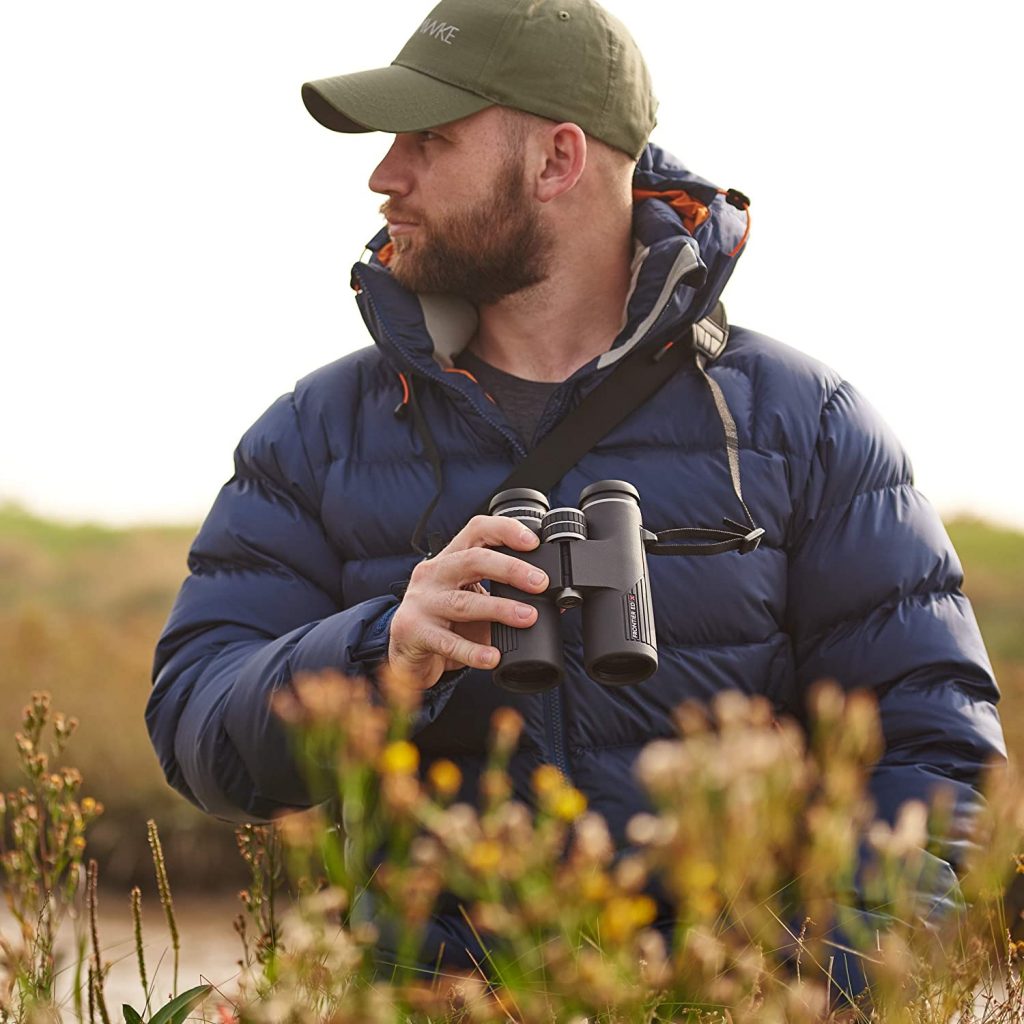
The better the optics and coatings are, the less light disappears in the binoculars. The simplest coating is a single layer, which has anti-reflexive characteristics, but also moderate capabilities. Many manufacturers use fully-coated optics on both lenses. Thanks to that, the light loss is fairly minimal.
However, multiple coatings are the best way of securing the highest image brightness and clarity. These coatings could be on one or multiple lenses, and even outside lens surfaces. You can come across partial and fully multi-coated coatings.
Phase coating can play an important role, especially in roof-prism binoculars. The idea is to optimize sharpness and brightness and ensure faithful replication of colors.
When it comes to the physical characteristics of your binoculars, it all starts with size and weight. If you are looking for the best small binoculars for safari, look for a compact unit like the Snypex Knight 8×32 Safari Binoculars. These binoculars are convenient to carry around, even if you have small hands. Bigger binoculars might be more suitable for those with large hands since it will be easier to get a good grasp of the product.
As for the weight, every ounce matters after several hours. The binoculars usually weigh between one and five pounds. If you plan to be outside the entire day, go with lightweight options like the Carson JR Series Full-Sized Waterproof Binoculars. If you don’t mind a few extra pounds, you can also consider heavier options. However, keep in mind that hand fatigue might appear after using heavy binoculars for a long time.
The durability of binoculars directly depends on the components chosen to make them. Numerous products, such as seen with the Snypex Knight 8×32 Safari Binoculars, use polycarbonate housing reinforced with fiberglass. Apart from that, you can expect a generous rubber armor that contributes to shock resistance. If your binoculars fall on the ground, that will protect them from damage. You can also consider lens covers that have the task of protecting the lenses of moisture, dust, and impacts.
As for fog resistance, it describes how well your binoculars are protected against moisture and condensation.
The O-ring seals and nitrogen-purging are two main ways of keeping the crucial components safe. Rain-guard eyepieces can join these parts in fighting against severe weather conditions.
Finally, you should also consider the waterproof rating. The waterproof levels might vary, and the highest ones are those that allow submerging your binoculars. The ratings can differ from IPX3 to IPX7 or higher, and their task is to protect the device from rain and other contacts with water.
Let’s take a look at other features that binoculars for safari could have:
When choosing binoculars for safari, it is important to stick to reliable brands. That means you will get an original product with the features promised. The list of reputable binocular brands includes Nikon, Bushnell, Leupold, Hawke, Celestron, Snypex, etc.
When it comes to prices, the cost of binoculars for safari can vary significantly. We can divide the cost into multiple ranges:
After carefully analyzing all details, we once again confirm that the Nikon 7576 Monarch 5 Binoculars are our favorite for safari. The product features the optimal balance of performance, durability, and aesthetics. It looks great, and it is easy to use, which makes it suitable for beginners. However, its performance is enough to meet the requirements of experienced users, too. You can use these binoculars in extreme conditions, and they will still last for a long time.
Next, the Bushnell H20 Binoculars are a great choice if you look for bargain deals. The lightweight product has a surprising level of water and fog resistance, and it offers impressive eye relief.
Lastly, the Hawke Frontier ED X 8×42 is another fantastic model for safari available. The premium binoculars offer a large field of view, impressive waterproof rating, and excellent image clarity.
Ultimately, don’t forget that it is all about choosing a suitable product for your needs. Consider your expectations and pick the best binoculars for safari accordingly to maximize your experience!
